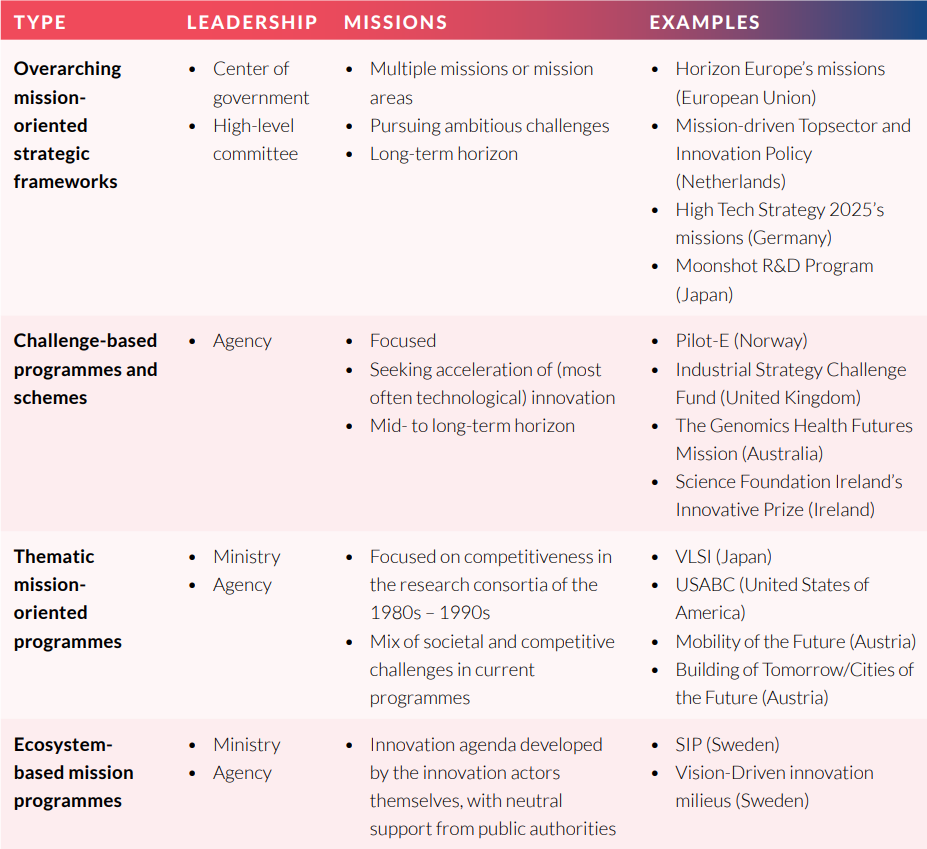Public Sector Innovation Facets: Mission-oriented innovation

What is mission-oriented innovation?
Mission-oriented innovation provides a policy framework for tackling the grand challenges facing governments today. The facet model supports governments to formulate measurable, ambitious and time-bound goals, and is often supported by three interlinked policy structures: institutional entrepreneurship and mission governance that enable collaboration and experimentation, available funding for a portfolio of missions, and the adoption of outcome-based procurement. Mission-oriented innovation thereby supports inclusive governance, progressive politics, generative environments and systemic impact.
The challenge
Rapid technological change, austerity policies and rising expectations of government services have put the public sector under increasing pressure to serve citizens better, faster and more efficiently, all while minimising costs. Governments are expected to extend choice in services, tailor and personalise these to particular user needs, and be evidence-informed in service allocation and decision making. Public sector organisations must enhance their current operating systems continuously, while at the same time demonstrating greater efficiency, user-centricity and value for money
Main drivers and enabling conditions of mission-oriented innovation
The most complex challenges that governments face require a wide range of solutions from basic scientific advances to modifying human behaviour. Mission-oriented innovation functions as a co-ordination mechanism, responds to the failure of traditional policy mechanisms and increases policy effectiveness. The OECD uses the following types of mission-oriented innovation: overarching mission-oriented strategic frameworks, challenge-based programmes, thematic programmes, and ecosystem-based programmes.

While many factors influence missions, current evidence indicates that mission-oriented innovation is often enabled by three interlinked policy structures: institutional entrepreneurship and mission governance, funding missions and public procurement.
- Institutional entrepreneurship highlights the need for an institutional infrastructure to discuss, design and implement the directions of innovation systems. This can include the creation of new or repurposing of existing co-ordination mechanisms (e.g. missions boards created by the European Union) as well as the creation of innovation and policy labs.
- Funding is an important factor in mission-oriented innovation, especially in regard to its influence on policy co-ordination, institution building and risk taking. Governments can repurpose or upgrade existing funding mechanisms or institutions to be more mission-oriented or create entirely new funding mechanisms and institutions.
- Public procurement is one of the key enabling conditions for mission-oriented policies. It is a demand-based instrument to incentivise private and third-sector partners to generate new solutions or adjust their production-related processes to a mission.
Tools and methods
Mission-oriented innovation is still an emerging practice and can in principle rely on a wide variety of policy-making tools and methods for implementation. The tools and methods increasingly favoured by public organisations implementing missions are experimentation and stakeholder engagement, a portfolio approach to funding and governance of projects, and new public value and spill-over-focused evaluation frameworks.

Participatory mission-setting in Barcelona
The Barcelona Metropolitan Strategic Plan (PEMB) is a multi-year plan for the city of Barcelona and the surrounding areas. In 2020-21, the PEMB identified 68 challenges facing the region. These will be transformed into 10 to 12 missions. Each mission will address four values: increasing resilience, prosperity, cohesion and creating a smart metropolis. As an example, one of the missions addresses local food security and will aim to derive at least one-third of food consumption from local products. For each mission a pilot group will be set up, consisting of members of civil society, academia, the public sector, the private sector and the media (based on a quintuple helix model). One particular challenge identified by the PEMB is the difficulty of creating convincing narrative and societal support for projects. However, the PEMB employs participatory processes such as the pilot groups to ensure that the transformation into missions is well-informed.
???????? Spain
Experimental and stakeholder engagement
The underlying principle behind an extensive engagement process is to generate a different kind of knowledge base for innovation policy action, one that is closer to “users” of specific policy outcomes.
Portfolio approach to funding and governing initiatives
Operational autonomy of mission-oriented funders and flexibility of mission-oriented funding are vital to avoid lock-in into one type of solution to solve a mission. The portfolio approach to funding missions can take the form of specifying mission themes and challenges, and then funding multiple projects with complementary approaches to solving the problem.
Evaluating mission-oriented innovation
Perhaps the key issue in the portfolio approach to transformational public policy is the framework and the concrete methodologies to appraise and evaluate such portfolios. It is not enough to evaluate mission outcomes; there is a need for reflexive measurement that captures how missions relate to systemic transformation, such as the holistic evaluation programme in Japan or public value mapping to gauge the market-shaping impact of public organisations.

The Mission Action Lab at the OECD
The OECD Mission Action Lab is a joint initiative of the OECD Observatory of Public Sector Innovation (OPSI), the OECD Directorate for Science, Technology and Innovation, and the OECD Development Co-operation Directorate. The OECD Mission Action Lab sets out to identify and analyse mission governance practice, and package insights into advice for governments. This advice aims to support governments in defining, setting up and governing large-scale missions. The Mission Action Lab aims to identify, compare and analyse practices, develop in-depth knowledge, and issue practical guidance addressing science and technology concerns and broader policy making and governance issues around mission-oriented innovation. It focuses on strengthening cross-sectoral and cross-disciplinary collaboration in countries. The work of the Mission Action Lab is action-oriented and focuses on tools and methods developed together with countries through concrete missions.
Source: OECD Observatory of Public Sector Innovation (2021)
Skills and capacities needed for mission-oriented innovation
A combination of both long-term capacities and dynamic or agile capabilities are key to successful mission-oriented innovation. Long-term capacities include the capacity to set a direction for development while continuously stress-testing the relevance of a mission in the future, govern and direct resilient production systems, and build public service infrastructure. Dynamic capabilities, on the other hand, refer to the capability to adapt and learn in the short term, harness citizen initiatives and innovation, and govern data and digital platforms. In addition, reflexive and flexible governance is increasingly important in the context of missions to reassess and adapt missions to new developments.
Policy relevance
Missions reflect wider societal and political debates about the nature and direction of economic growth, innovation and public services. In the context of “wicked” challenges such as climate change, cancer or clean oceans, short-term, single stakeholder approaches are no longer sufficient. Mission-oriented innovation can produce more effective ways to tackle the “grand challenges” facing governments today. They ensure inclusive governance, progressive politics, a generative environment and systemic impact. In addition, missions can act as a tool for wider co-ordination across multiple sectors and policy arenas. Mission-oriented innovation can help policy makers engage incumbent actors (industry, universities) in mission-oriented policy discussions, especially in contexts where such actors, often in the private sector, lead in research and development (R&D) investments.
This work received funding from the European Union‘s Horizon 2020 research and innovation programme under grant agreement No. 870913

Public Sector Innovation Facets: Mission-oriented innovation
Published on 27 October 2021.
